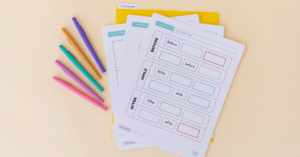This is a guest blog post by Monica, a school-based SLP, all about how to use neurodiversity-affirming practices to build relationships with students!
If you’ve ever wondered how to build a relationship during speech sessions, I’m here to help! I’ve been using neurodiversity-affirming practices for a long time and am constantly shifting and changing. I’ll outline my approach and share what I’ve learned from autistic adults and other essential voices in the disability community. There will also be a lot of links to resources.
As a person of color and a neurodivergent SLP, my therapy approach has always been different. With more people talking about the neurodiversity-affirming movement, I have words to label what I’ve been doing. I have a neurodiversity-affirming, trauma-informed, and culturally responsive approach. It’s a mouthful, but I think it works wonders! I acknowledge that it is a unique time, where there are a lot of shifts happening in society which can be really overwhelming! Providing support communicates to our students that they are welcome as they are, and we will provide the tools to help them succeed. We’ll dig into some basic principles with some real-life examples, and by the end, I’m hoping that you’ll feel comfortable enough to incorporate some of them into your own practice.
First things first, a straightforward way to define a neurodiversity-affirming approach is to think of it as modifying the environment and providing supports, instead of expecting children to change themselves.
Ross Greene (2019) states that children do well when they can and that behind every challenging behavior is an unsolved problem or lagging skill.
In the article Collaborative & Proactive Solutions (CPS): A Review of Research Findings in Families, Schools, and Treatment Facilities, the CPS model is outlined, and a checklist of “lagging skills” to lead discussions for “unsolved problems” is included (Green and Winkler, 2019). In this list are executive functioning needs, sensory/motor difficulties, difficulties with transitions, and mental health needs–just to name a few. This article would be great when discussing making changes with other team members and administration.
This website by AutisticSLT (Emily Lees) in the UK is a fantastic resource on a neurodiversity-affirming approach.
We owe it to our students to learn about self-regulation skills and how to modify environments to help them succeed. By providing support to our students, we build trust and a relationship with them by communicating that we see their struggles and will help shape their environment, rather than putting the burden on them to change. I’ll go over a couple of different support areas for you to individualize for your students, keep in mind that this is not an exhaustive list.
If you want to learn more, check out these blog posts:
– How to Support Sensory Needs
– How to Support Executive Functioning
– How to Support Anxiety and Other Mental Health Needs
– How to Incorporate Trauma-Informed Practices
– How to Be Culturally Responsive
References
Greene, R., & Winkler, J. (2019). Collaborative & Proactive Solutions (CPS): A Review of Research Findings in Families, Schools, and Treatment Facilities. Clinical Child and Family Psychology Review, 22(4).




Reader Interactions